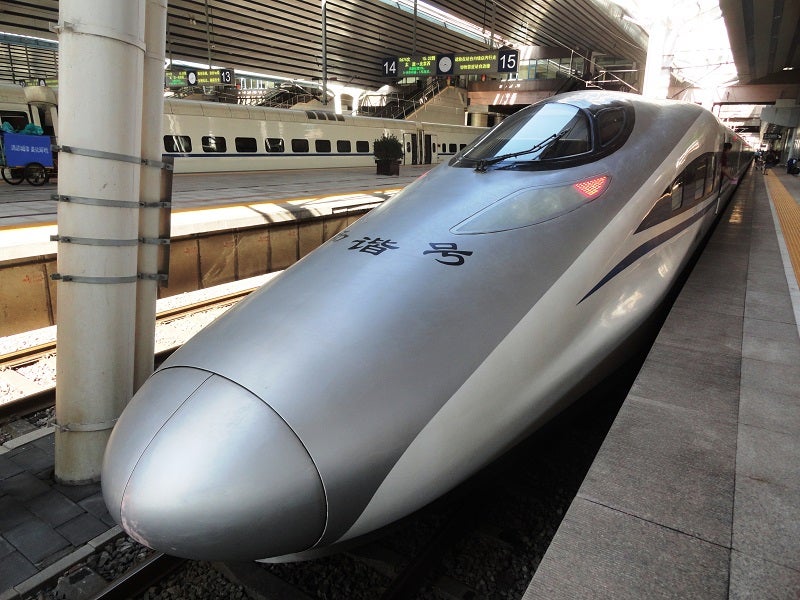
1997 – 2007: Early high-speed plans and works
In the late 1990s, China was facing a huge increase in capacity demands, which forced it to invest in making its transport network faster and more efficient.
Early improvements to its existing railway infrastructure kicked off in 1997 and were carried out over a ten-year period during which different sections of the existing network – and the trains running on them – were sped up to reach a top speed of 160 km/h. In 2007, the first intercity high-speed trains were first rolled out on the improved tracks.
2007 – 2008: First high-speed track inaugurated
With capacity demands still far from being met, the Chinese Government continued on its plans to shift to high-speed across the country.
As a result, China’s first high-speed railway track was officially inaugurated in August 2008. Connecting the capital Beijing and the city of Tianjin in about 30 minutes, the line is still in use and can reach a top speed of 350km/h.
2008 – 2013: Shanghai-Wuhan-Chengdu
A landmark year in the history of China’s transport system, the year 2008 also saw the inauguration of the first tract of the Shanghai-Wuhan-Chengdu line running between the eastern and western parts of the country.
Having opened one portion of it in 2008, the line was completed in 2013; it has reduced travel time by 20 hours and created a solid link from the Yangtze River Delta to east and south-central China.
How well do you really know your competitors?
Access the most comprehensive Company Profiles on the market, powered by GlobalData. Save hours of research. Gain competitive edge.

Thank you!
Your download email will arrive shortly
Not ready to buy yet? Download a free sample
We are confident about the unique quality of our Company Profiles. However, we want you to make the most beneficial decision for your business, so we offer a free sample that you can download by submitting the below form
By GlobalData2008 – 2017: Qingdao-Taiyuan
Another line spanning from east to west, the Qingdao-Taiyuan network was launched in 2017 with the inauguration of the Shijiazhuang-Jinan track.
Relatively small compared to other existing routes, the Qingdao-Taiyuan goes from the coastal city of Qingdao to Taiyuan, just southwest of Beijing. The government is now considering extending it towards Yinchuan.
2009 – 2013: Hangzhou-Fuzhou-Shenzhen
The Shanghai-Fuzhou-Shenzhen route spans from north to south along China’s eastern coast, allowing faster connections between two key rivers, the Yangtze and the Pearl, in under eleven hours.
The final part of the line, going from Shanghai and Hangzhou is still under construction, as the government plans a further expansion to other major hubs located near the coast.
2009 – 2018: Beijing – Hong Kong
The longest high speed railway in the world, the Beijing – Hong Kong line connects China’s two most important hubs in less than ten hours and was finally inaugurated in September 2018.
Particularly worthy of mention is the class of Vibrating Express bullet trains, which was inaugurated in 2018, commuting between Hong Kong and the city of Guangzhou, the third largest in the country, in under 50 minutes.
2010 – 2016: Shanghai-Kunming
A remarkable piece of engineering and efficiency, the Shanghai-Kunming line spans from the east coast and Shanghai to several southwestern cities. Trains running on its 2,200 km-long tracks pass in front of some of the most breath-taking landscapes China has to offer, making the Shanghai-Kunming one of the most beautiful routes in the country.
Although the last part of the tracks was opened in 2016, the government is now planning to further extend the railway southwards, creating a high-speed connection between China, Laos and other Southeast Asian countries.
2010 – 2017: Xuzhou-Lanzhou
Having been completed only two years ago, works on the Xuzhou-Lanzhou line might soon restart as part of government plans to extend it eastbound to Lianyungang. Some high-speed trains running on this line are also now travelling from its western end, Lanzhou, to the northwest part of China and the region of Xinjiang. Once expanded towards Lianyungang, it will be one of the longest lines crossing the country from east to west.
2011 – 2012: Beijing – Shanghai
One of the busiest lines of the entire network, the Beijing – Shanghai connects the two hubs in six hours. On the sixth anniversary of its opening, in 2017, it was announced it had served a staggering 630 million passengers since 2011.
2012 – 2019: Beijing-Harbin
High-speed trains on this recently-completed line run from Beijing to the northeast centre of Harbin in seven hours, while a second portion of the route links Harbin to port city of Dalian, on the Liaodong Peninsula, in less than five hours.






